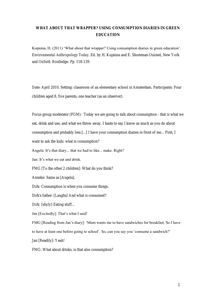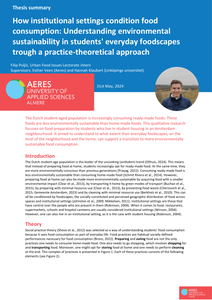Environmental or ‘green' education is an important driving force behind the ‘greening' of society as it plays a critical role in raising environmental awareness and preparing students for green jobs. None of the existing environmental attitudes and behavior measures is focused on the evaluation of green education, especially in relation to consumption. To date, no longitudinal studies of children and students' attitudes towards consumption influenced by education exist. Also, little has been done to explore the socio-cultural context in which attitudes toward consumption are being formed and to explain the cross-cultural differences in environmental attitudes. This pilot study is designed to take the first step towards developing methods complementing existing quantitative measurements with qualitative strategies, such as consumption diaries, focus groups, and concept mapping. While this research is just a first attempt to tackle children's knowledge and attitudes consumption, preliminary results of the research on which this chapter is based and enthusiasm of the research participants encourage the author to stress the importance of consumption studies as part of green education for educational program developers. As a chapter of this volume, the author hopes that this study will add to the anthropological depository of research on the cultural variants in the perception of the environment in children. This chapter draws upon the consumption diaries collected from the upper-elementary school children in Amsterdam, The Netherlands, between September 2009 and May 2010. Consumption diaries are chronological documents recording purchase, use, and waste of materials, which can be used both as analytical tools and the means to stimulate environmental awareness. The four main methodological steps involved in this research were as follows. Children were asked to complete the consumption diary, paying specific attention to use and waste materials. Consequently, focus group meetings were held with parents and their children to discuss the diaries. Finally, interviews with the children were conducted in order to generate statements that supplement those generated by focus groups for carrying out the concept mapping analysis. The concept mapping analysis was then conducted to organize the order and analyze the ideas expressed in the focus group and interview sessions. This is an Accepted Manuscript of a book chapter published by Routledge/CRC Press in "Environmental Anthropology Today" on 8/5/11 available online: https://doi.org/10.4324/9780203806906 LinkedIn: https://www.linkedin.com/in/helenkopnina/
MULTIFILE

This paper describes a study into consumers' reasons for buying socially responsible (SR) products, such as Fair Trade products and organic meat. As opposed to other studies, we use a qualitative approach based on 25 in-depth interviews and include several different products in the research. This leads to several new results, such as: (1) buying SR products is perceived as an imperfect moral duty; (2) low quality of SR products is a dissatisfier, but high quality not a satisfier; (3) the attitude towards SR products is related to the reputation of charitable funds; (4) the demand for SR products is negatively related to the frequency of purchasing SR products; (5) reflection on SR products raises the demand for SR products; (6) consumers that have witnessed the social problems that SR products aim to alleviate purchase more SR products. Finally, we find that the demand for different SR products is correlated: if a consumer buys one SR product, it is more likely that (s)he purchases other SR products as well.
DOCUMENT

As multifunctional places that combine shopping and hospitality with public space and residential functions, urban consumption spaces are sites where different normative orders surface and sometimes clash. In Amsterdam, such a clash emerged over touristification of consumption spaces, eroding place attachment for local residents and urging the city government to take action. Based on policy analysis and interviews with entrepreneurs and key informants, we demonstrate how Amsterdam’s city government is responding to this issue, using legal pluralism that exists within formal state law. Specifically, the city government combines four instruments to manage touristification of consumption spaces, targeting so-called tourist shops with the aim to drive them out of the inner city. This strategic combination of policy instruments designed on various scales and for different publics to pursue a local political goal jeopardizes entrepreneurs’ rights to legal certainty. Moreover, implicitly based on class-based tastes and distrust towards particular minority groups of entrepreneurs, this policy strategy results in institutional discrimination that has far-reaching consequences for entrepreneurs in itself, but also affects trust relations among local stakeholders.
DOCUMENT

In reflecting on Dutch Christmas shoppers, this article will discuss environmental Kuznets curve (EKC), postmaterialist values hypothesis, and ecological modernization theory. According to the EKC hypothesis, while at the initial stages of industrialization material resources are often used unsustainably, continuing industrialization leads to a threshold after which lead to progressively more sustainable technologies. According to the postmaterialist values hypothesis, only wealthier societies can ‘afford’ to care about the environment, assuming that wealth will lead to development of greater concern about and valuation of environment. Finally, ecological modernization theory postulates that environmental conditions improve with advanced technological development and suggests that enlightened self-interest, economy and ecology can be favourably combined and that productive use of natural resources can be a source of future growth. In generalizing economic, political and social trends in relation to consumption in The Netherlands, the aim of this article is to consider the consequences of Western-style consumption for the enterprise of global development. https://doi.org/10.1016/j.scs.2013.05.004 https://www.linkedin.com/in/helenkopnina/
MULTIFILE

This study proposes a framework to measure touristification of consumption spaces, consisting of concentration of retail capital, business displacement and standardization of the consumption landscape. This framework is tested using business registration data and rent price estimates for consumption spaces in Amsterdam between 2005 and 2020. Touristification emerges from concentrations of retail capital and standardization, but occurs without causing significant business displacement. A cluster analysis identifies different variations of touristification. Besides the more typical cases these include nightlife areas, gentrifying consumption spaces and specialized retail areas. This suggests that local contingencies cause consumption spaces to respond differently to increasing tourism.
DOCUMENT

The purpose of the research we undertook for this Conference Paper was to investigate whether marketing campaigns for specific types of drinks could be directed towards age cohorts rather than towards intercultural differences between countries. We developed consumer profiles based on drinking motives and drinking behavior by age cohorts. We hypothesized that differences between countries in the youngest age groups are smaller than in the older age groups, where country specific tradition and culture still plays a more prominent role. We, therefore tested, from the data obtained by the COnsumer BEhaviouR Erasmus Network (COBEREN), the hypothesis that the extent to which the age specific profiles differ between countries increases with age. The results confirm our hypothesis that the extent to which drinking motives differ between countries increases with age. Our results suggest that marketing campaigns which are directed towards drinking motives, could best be tailored by age cohort, in particular when it concerns age group 18-37 and more particular for beer, spirits and especially premix drinks. Marketing campaigns for non-alcoholic beverages should be made specific for the British countries and the Western countries, but even more effectively be made specific for the age cohort 18-37.
DOCUMENT

This article explores cooperation between a commercial supermarket chain and an environmental non-governmental organization linking it to consumer perception of the “The Super Animals” collectable cards promotion initiative. The case study focuses on one particular joint project involving Animal Cards that was initiated by the supermarket Albert Heijn and the World Wide Fund for Nature in The Netherlands. Based on this case, environmental non-governmental organizations’ strategic choices in the context of contesting discourses of sustainability and consumption, as well as implications for environmental education, are addressed. This article combines three strands of the literature – on sustainable consumption, on strategic cooperation between commercial companies and environmental non-governmental organizations and on environmental education. It is argued that the Animal Cards initiative presents an ambiguous case by both attempting to enhance environmental awareness and promoting consumption, opening up questions about the value of such cooperative ventures to the objectives of environmental education. It is concluded that cross-sector partnerships have the potential to lead to improvements in corporate social responsibility and environmental awareness among consumers but simultaneously pose the danger of undermining the critical stance toward consumption. https://doi.org/10.1177/1469540514556170 LinkedIn: https://www.linkedin.com/in/helenkopnina/
MULTIFILE

The Dutch student-aged population is increasingly consuming ready-made foods. These foods are less environmentally sustainable than home-made foods. This qualitative research focuses on food preparation by students who live in student housing in an Amsterdam neighbourhood. It aimed to understand to what extent their everyday foodscapes, on the level of the neighborhood and the home, can support a transition to more environmentally sustainable food consumption. This is a thesis summary.
DOCUMENT

Sustainable consumption is interlinked with sustainable production. This chapter will introduce the closed-loop production, the circular economy, the steady state economy, and Cradle to Cradle (C2C) models of production. It will reflect on the key blockages to a meaningful sustainable production and how these could be overcome, particularly in the context of business education. The case study of the course for bachelor’s students within International Business Management Studies (IBMS) program at three Universities of Applied Science (vocational schools), and at Leiden University College in The Netherlands will be discussed. Student teams from these schools were given the assignment to make a business plan for a selected sponsor company in order to advise them how to make a transition from a linear to circular economy model. These case studies will illustrate the opportunities as well as potential pitfalls of the closed loop production models. The results of case studies’ analysis show that there was a mismatch between expectations of the sponsor companies and those of students on the one hand and a mismatch between theory and practice on the other hand. The former mismatch is explained by the fact that the sponsor companies have experienced a number of practical constraints when confronted with the need for the radical overhaul of established practices within the entire supply chain and students have rarely considered the financial viability of the "ideal scenarios" of linear-circular transitions. The latter mismatch applies to what students had learned about macro-economic theory and the application through micro-economic scenarios in small companies. https://www.springer.com/gp/book/9783319656076 LinkedIn: https://www.linkedin.com/in/helenkopnina/
MULTIFILE

Touristification of consumption spaces describes a process in which retail and hospitality businesses adapt to the tourist demand, eroding place attachment among local residents. While this is an important cause of resistance to tourism, little is known about the mechanisms that drive or mediate this process. We address this gap by interviewing entrepreneurs in Amsterdam. We found three distinct areas in close proximity where entrepreneurs responded to increasing tourism in markedly different ways; by crowd-pleasing, niche-playing and gentrifying. The resulting microgeographies of touristification of consumption spaces have not only been overlooked in literature, but also in urban policies. This causes a mismatch between the more generic, city-wide regulation and the highly differentiated effects of tourism on consumption spaces.
DOCUMENT
